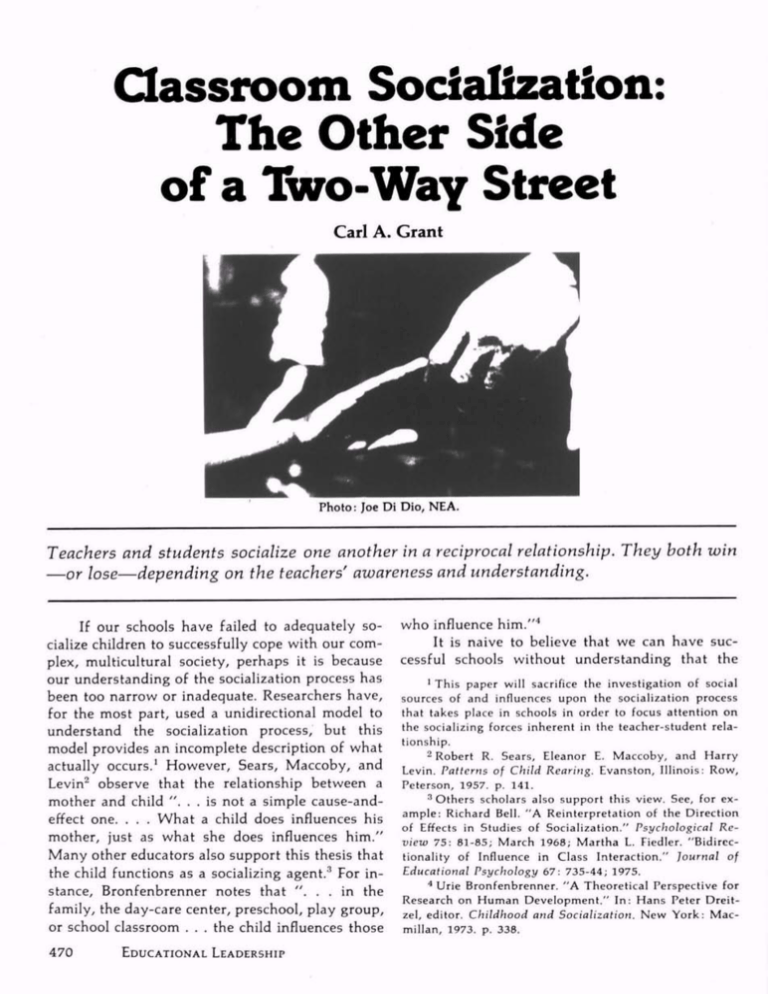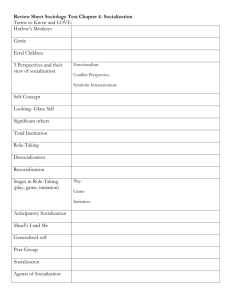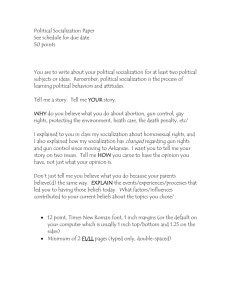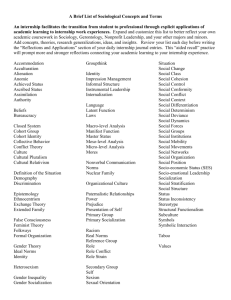
Classroom Socialization:
The Other Side
of a Two-Way Street
Carl A. Grant
Photo: Joe DiDio,NEA.
Teachers and students socialize one another in a reciprocal relationship. They both win
—or lose—depending on the teachers' awareness and understanding.
If our schools have failed to adequately so
cialize children to successfully cope with our com
plex, multicultural society, perhaps it is because
our understanding of the socialization process has
been too narrow or inadequate. Researchers have,
for the most part, used a unidirectional model to
understand the socialization process, but this
model provides an incomplete description of what
actually occurs. 1 However, Sears, Maccoby, and
Levin2 observe that the relationship between a
mother and child ". . . is not a simple cause-andeffect one. . . . What a child does influences his
mother, just as what she does influences him."
Many other educators also support this thesis that
the child functions as a socializing agent. 3 For in
stance, Bronfenbrenner notes that ". . . in the
family, the day-care center, preschool, play group,
or school classroom . . . the child influences those
470
EDUCATIONAL LEADERSHIP
who influence him."4
It is naive to believe that we can have suc
cessful schools without understanding that the
1 This paper will sacrifice the investigation of social
sources of and influences upon the socialization process
that takes place in schools in order to focus attention on
the socializing forces inherent in the teacher-student rela
tionship.
2 Robert R. Sears, Eleanor E. Maccoby, and Harry
Levin. Patterns of Child Rearing. E vanston, Illinois: Row,
Peterson, 1957. p. 141.
3 Others scholars also support this view. See, for ex
ample: Richard Bell. "A Reinterpretation of the Direction
of Effects in Studies of Socialization." Psychological Re
view 75: 8 1-85; March 1968; Martha L. Fiedler. "Bidircctionality of Influence in Class Interaction." J ournal of
Educational Psychology 67: 735-44; 1975.
4 Urie Bronfenbrenner. "A Theoretical Perspective for
Research on Human Development." In: Hans Peter Dreitzel, editor. C hildhood and Socialization. N ew York: Macmillan, 1973. p. 338.
deliberate and unintentional actions of both teach
ers and students working in the classroom en
vironment have an effect on each other. The effect
is often substantially increased when the teacher
and students are of different racial and cultural
backgrounds, especially if they have made little
effort to understand one another and how they
influence one another.
According to the literature, schools try to
serve as a primary source of the socialization of
the young into the norms of society. Dreeben has
written that ". . . schooling helps pupils to learn
what the norms are, to accept those norms, and
to act according to them."2 Both teacher and stu
dent are socialized into both deliberate and un
intentional roles that are defined according to
prescriptive and prescriptive norms. Prescriptive
(forbidding certain conduct) and prescriptive
(specifying desired conduct) norms, largely re
lated to the order and welfare of the school, em
phasize the status .elationship between teacher
and student6 to the neglect of norms that could
promote reciprocal student-teacher interaction and
respect for diversity.
However, in spite of the attention to the
socialization process directed toward these pre
conceived norms, the schools fail to transmit con
formity. This failure, however, is not in many
ways necessarily bad, because failure to transmit
conformity does not deplete the soil of pluralism,
which is fertile for social growth and change. Our
society needs to promote diversity and creativity
in order to maintain its pluralistic composition and
in order to have the resources to effectively re
spond to and direct social change. Zvi Lamm pro
vides an illuminating comment that helps illus
trate this point.
systems, if they do not keep pace with the chang
ing and growing ambitions and desires of all o f
their clients. A contradiction between the goals of
education for a racially and culturally diverse
society and the continuing socialization in only
middle class ethnocentric norms causes instruc
tion to fail, as evidenced by such things as student
rejection of instruction, truancy, poor classroom
behavior, and academic disinterest.
To the extent that students influence teach
ers to change classroom procedures or to justify
the value of existing procedures in spite of poor
student reception, the reciprocal nature of sociali
zation is demonstrated. In other words, teachers
either accept student diversity and modify their
teaching accordingly, receiving student apprecia
tion, or they reject differences displayed by stu
dents, and cling tenaciously to preconceived
standards, thus receiving fewer of the rewards so
important to their professional and personal wellbeing.
For many teachers, the rewards of the pro
fession are "intrinsic" or "psychic" and are tied
to "task-related outcomes."8 In other words, "stu
dents are the primary determinant of how the
teacher feels and is made to feel, that her worth
as a teacher will be judged by how much her class
learns in a given period of time."9
Many teachers, in their desire to be rewarded,
try to reach their students. This reaching often
causes teachers to change or broaden their class
room norms, which in turn requires them to reexamine and make changes in their behaviors and
attitudes. Accounts of these changes have been
reported, for example, by Kohl 10 and Herndon.' 1
Brophy and Good cite research that indicates that
Socialization is, on the one hand, essentially a
technique for adapting young people to existing social
conditions. On the other hand, social conditions may
demand innovative rather than conformist behavior.
But the school, guided by the idea of socialization,
cannot at the same time promote the adaption of its
pupils to existing society and their willingness to
accept or effect social change . . . the school cannot
maintain a system of instruction that simultaneously
promotes both creativity and conformity, both openand closemindedness. 7
5 Robert Dreeben. O n What Is Learned in School.
Reading, Massachusetts: Addison-Wesley, 1968. p. 46.
6 H. Otto Dahlke. Values in Culture and Classroom.
New York: Harper & Row, 1958. pp. 2 28-30.
7 Z vi Lamm. C onflicting Theories of Instruction.
Berkeley, California: McCutchan, 1976. p. 117.
8 D. Lortie. S chool Teacher. Chicago: University of
Chicago Press, 1975. pp. 103-07.
Schools cannot meet the goal of a multicul
tural society that is assumed by this paper, and
which is an explicitly stated goal of many school
10 Herbert Kohl. 3 6 Children. N ew York: Signet, 1968.
11 James Herndon. T he W ay I t Spozed to Be. New
York: Bantam Books, 1968.
9 Seymour B. Sarason. The Culture of the School and
the Problem of Change. Boston: Allyn and Bacon, 1971.
p. 1 52.
APRIL 1979
471
"teacher behavior changes as a function of
changes in student behavior." 12
Examples
One example occurred in a school with a
large Hispanic student population. In order to
meet the needs of many Hispanic students, the
teachers at the school decided to have morning
and afternoon announcements in both Spanish
and English, and also to send notices home in
both languages. Additionally, several of the teach
ers requested an after school Spanish class for
interested faculty members. Over 40 percent of
the non-Spanish-speaking faculty members were
enrolled in the class, and during the year several
teachers began incorporating Spanish vocabulary
into their regular class instruction. An example
of what can happen when teachers and students
do not come to understand one another is pro
vided in a frightening but realistic account of the
resocialization of teachers in a central Harlem
school. 13 After only a few days, the teachers for
got their professional purpose was to help chil
dren learn. They felt they were in a contest of
survival against students. This resulted in part,
according to the authors, "from prior race and
"We need to examine the socialization
process of both teachers and students and
apply the results of the examination to our
curriculum and teaching procedures. It
should be done in a comprehensive man
ner, using both traditional and nontraditional methods of research, . . . ."
class prejudice, perhaps developed from rumors
and media reports of the 'slum school' as a
blackboard jungle, but more often it resulted from
assorted difficulties with individuals and groups
of school children during the teachers' first days
on the job. [The] contest mentality also stemmed
from children's sense of schooling as a contest in
which one could be bored, ashamed, or made to
feel inferior."" Many of the teachers moved from
a more open and idealistic philosophy of teaching
to one of rigid authority and control, of drill and
472
EDUCATIONAL LEADERSHIP
practice. Control, in essence, became their major
objective.
In such a situation, both teachers and stu
dents are losers. Teachers lose because they do
not get the reward of student respect. Students
lose because their culture and individual differ
ences are not recognized as legitimate and because
they fail to master basic skills in a society in
which success requires intellectual competence.
We need to examine the socialization process
of both teachers and students and apply the re
sults of the examination to our curriculum and
teaching procedures. It should be done in a com
prehensive manner, using both traditional and
nontraditional methods of research, but teachers
should begin immediately to do "action research"
in their own classrooms. A few suggestions are
offered here to help them get started.
Becoming Aware
As most teachers know, induction into the
teaching profession largely relies on "learningwhile-doing"; teacher education does not end
when one becomes certified. 15 Teachers should be
encouraged to see their career growth as continu
ous, and changes they make in their classroom,
especially those related to understanding students,
as demonstrating professional sophistication. It is
important that teachers continually reexamine
their behavior because "in working out a task an
individual develops certain beliefs, values, and
preferences to the task itself, which over time are
generalized to other areas of life." lli For example,
many teachers have found that minority students
do not fit their preconceived stereotypes. Finding
that individual students differ from one another,
they reject stereotypes about minorities, which
leads them to question stereotypes in other areas
as well. That can lead to a reduction in stereo
typing on the basis of sex, age, or handicap.
Y~ J ere E. Brophy and Thomas L. Good. TeacherStitdent Relationships. New York: Holt, Rinehart and
Winston, 1974. pp. 276-77.
13 B. Silverstein and R. Krate. C hildren of the Dark
Ghetto. N ew York: Praeger, 1975. p. 218.
» I bid.
lo Lacey, The Socialization of Teachers.
lc Dreeben, On What Is Learned in School, op. cit.,
pp. 49-50.
Brophy and Good 17 have suggested three
obstacles to teacher awareness about the recipro
cal nature of socialization in the classroom. Teach
ers should be conscious of these obstacles in
order to try to overcome them. The first is the
rapid pace of the classroom. Jackson reports that
teachers sometimes participate in as many as
1,000 interpersonal interchanges each day, and
make more than 200 decisions hourly. 18 A school
should have provisions for helping teachers ana
lyze the patterns in their interpersonal inter
changes and decision making. Students should
be encouraged to express their feelings about the
quality of the decisions made and the manner in
which they are made.
A second barrier is ego defensiveness related
to student classroom failure and success. Teachers
feel a sense of inadequacy if their students don't
succeed and are proud if they do. If teachers were
to share the consequences, both failures and suc
cesses, of classroom action with students and
others, they would increase their opportunity for
success and have partnership support. A third
barrier is individual differences in teachers' pat
terns of contact with students. Teachers con
sciously or unconsciously tend to respond to
students as members of groups rather than as
individuals. Research evidence indicates that
teachers often have different expectations, use a
different wait time, give different rewards, and
group students differently according to race, sex,
and socioeconomic status. 19 Teachers should be
helped to discover the extent to which this is
occurring. They could get feedback about their
own behavior by inviting others to observe their
classes or by holding classroom meetings in which
students are encouraged to speak their minds.
They might also use suggestion boxes, knowing
that students may be unwilling to say what they
think because they are the weaker partners in
the reciprocal relationship.
Overcoming Embarrassment
One of the reasons some teachers have diffi
culty in working with culturally different students
is that they are embarrassed to ask for help. The
teachers who are embarrassed should be encour
aged to understand that it is all right to feel
uncomfortable about needing help. Sarason says,
"No group more than teachers are as aware that
the preparation of teachers ill prepares them for
the realities of the classroom life."20 There are a
number of excellent papers that suggest how to
help teachers work in a multicultural setting, so
I will not discuss that here. However, I will say
it is important to encourage teachers to identify
their problems in working with teachers, and to
encourage dialogue between them.
Acknowledging and Learning
About Student Culture
In order for them to better understand how
students influence their behavior it is essential for
teachers to be aware of the values, beliefs, and
norms that make up student culture as well as
student countercultures. Several observers have
detectpd a strong student peer culture in schools
that is different from, and frequently at variance
with, the goals and values of the school.21 Willis
notes that "the most basic, obvious and explicit
dimension of counter-school culture is entrenched
general and personalized opposition to 'author
ity'."22 Student cultures can influence the way in
which students perform academically and socially.
17 B rophy and Good, Teacher-Student Relationships,
op. cit., p p. 270-95.
18 Philip W. J ackson. L ife in Classrooms. New York:
Holt, Rinehart and W inston, 1 968. p. 11.
19 See, for example: Patricia M. Cunningham. 'Teach
ers Correction Responses to BlackrDialect Miscues Which
Are Non-Meaning-Changing." Reading Research Quar
terly 1 2:637; Mary Budd Rovve. "Wait-Time and Rewards
as Instructional Variables, Their Influence on Language,
Logic, and Fate Control: Part One Wait-Time." Journal
of Research in Science Teaching 1 1:81.
20 Sarason, T he Culture of School and the Problem of
Change, op. cit., p . 155.
21 See, for example: James Coleman. The Adolescent
Society. New York: Free Press, 1961; P. Cusick. Inside
High School. New York: Holt, Rinehart and Winston,
1973; Willard Waller. The Sociology of Teaching. New
York: Russell and Russell, 1961.
22 Paul Willis. L earning to Labor. Westmead, Eng
land: Saxon House, 1977. p. 11.
APRIL 1979
473
PEACE OF MIND)
AT AN
EARLY AGE
by Grace H. Pilon, SBS
This book tells:
HOW TO CREATE NEW LEARNING
POWER IN CHILDREN
HOW TO NOURISH, IN THEM,
A POSITIVE SELF-CONCEPT
$6.95
Many students express boredom, discontent, or
mixed feelings about going to school. 21 This bore
dom can lead students to do nothing or to employ
what Goffman calls "impression management,"
as in the case when a student becomes "a char
acter" in order to manipulate the situation.24 A
number of times I have seen minority students
act out racial stereotypes they believe teachers
have. The teacher becomes more convinced of
the accuracy of the stereotype, which in turn in
fluences the teacher's reactions. Once again, stu-
Carl A. Grant is Asso
ciate Professor, School
of Education, Univer
sity of Wisconsin—
Madison.
Write for information on:
*The WORKSHOP WAYi
*0ther books by author
*Summer courses at Xavier
The WORKSHOP HAY, Inc.
Xavier University, Box 144C
7325 Palmetto Street
New Orleans, LA 70125
J
LETTERS
(Continued from page 453)
knowledge is possible from information like that
presented by Bennett. Educational Leadership
should publish more articles of this tenor and
quality.
Geneva Gay
Associate Professor of Education
Purdue University
West Lafayette, Indiana
Have Something to Say?
If so, write to us. Letters to the editor are
usually edited for brevity and are printed only
if space is available. Letters must be signed,
although we will withhold an author's name
if requested.
474
EDUCATIONAL LEADERSHIP
dents lose, and teachers are unable to break the
cycle of nonachievement.
Having academic and social success with stu
dents in cooperation with or in spite of the stu
dent culture requires an understanding of it.
Student culture can be difficult to understand
even though teacher and students are members
of the same cultural group. When different cul
tures are involved, it becomes more difficult still
but also more essential.
Not a One-Way Street
The socialization process is not a one-way
street. Both teachers and students are affected by
one another. If schools are to have greater mean
ing for students, especially minority students, the
reciprocal nature of socialization will have to be
recognized and affirmed by both partners in the
relationship. That should enable them to better
understand and effect social change, instead of
becoming victims of the faceless "they" who have
too often and too long moved us in the wrong
direction.
-^ J ackson, L ife in Classrooms, op. cit., p p. 39-81.
24 E. Goffman. T he Presentation of Self in Everyday
Life. H armondsworth: Penguin, 1971. p. 244.
Copyright © 1979 by the Association for Supervision and Curriculum
Development. All rights reserved.







